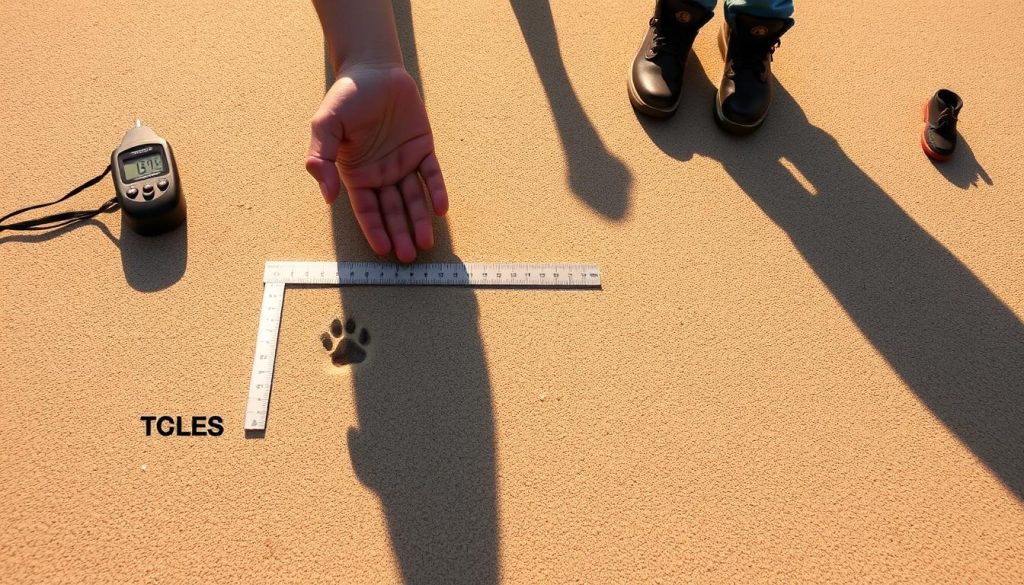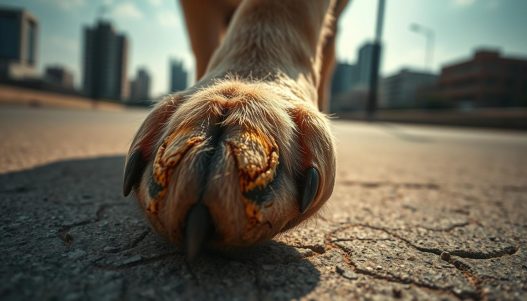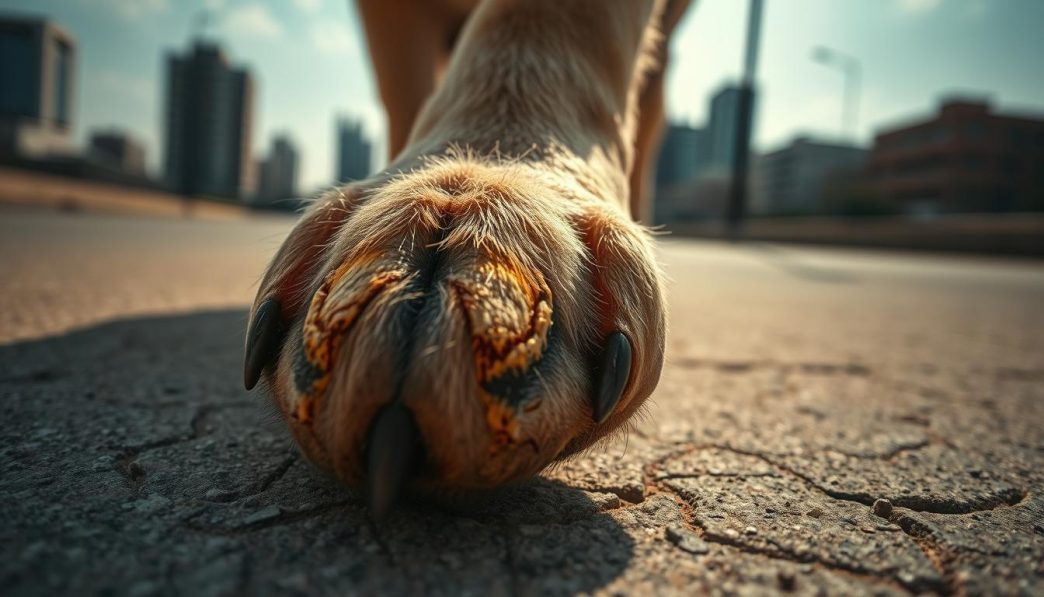As summer approaches, dog owners are excited to spend more time outdoors with their pets. However, the hot weather brings a hidden danger: scorching pavement that can cause serious burns to dogs’ paws.
Hot pavement can be particularly hazardous for dogs, as their paws are sensitive to extreme temperatures. When the surface temperature exceeds 125°F (52°C), it can lead to painful burns, blisters, and long-term damage.
As a responsible dog owner, it’s essential to take measures to protect your pet’s paws from the heat. In this article, we’ll explore the importance of dog paw safety and provide valuable tips on how to prevent summer pavement burns.
Key Takeaways
- Hot pavement can cause serious burns to dogs’ paws during summer.
- Surface temperatures above 125°F (52°C) can lead to painful burns and blisters.
- Protecting your dog’s paws is crucial for their overall health and well-being.
- Simple measures can be taken to prevent summer pavement burns.
- Dog owners should be aware of the risks and take proactive steps to ensure their pet’s safety.
The Hidden Danger Beneath Your Dog’s Feet
The scorching heat of summer reveals a hidden peril beneath our feet and our dogs’. As temperatures soar, pavements become extremely hot, posing a significant threat to our canine friends.
During the summer, the surface temperature of pavements can be much hotter than the air temperature, sometimes reaching temperatures that can cause burns to a dog’s paw pads.
Why Summer Pavements Pose a Serious Threat
Summer pavements can get dangerously hot, with temperatures often reaching as high as 145°F (63°C) or more. This extreme heat can cause immediate burns to a dog’s paw pads, leading to pain and potentially long-term damage.
The Alarming Statistics of Paw Pad Burns
Statistics on paw pad burns are alarming, with many dog owners unaware of the risks. According to veterinary reports, a significant number of dogs suffer from paw pad burns each summer, highlighting the need for awareness and preventive measures.
Understanding Your Dog’s Paw Pads
The intricate design of canine paw pads makes them both resilient and vulnerable to heat damage. To appreciate why paw pad protection is crucial, it’s essential to understand their anatomy and function.
Anatomy of Canine Paw Pads
Dog paw pads are made of thick, fatty tissue and skin that provide cushioning and support. They contain sweat glands that help dogs regulate their body temperature. The pads are also rich in nerve endings, making them sensitive to touch and temperature.
Why Paw Pads Are Vulnerable to Heat Damage
Paw pads are susceptible to heat damage because they are in direct contact with hot surfaces. The skin on paw pads is sensitive, and when exposed to high temperatures, it can suffer burns. Factors such as the dog’s size, coat color, and individual tolerance to heat can influence their vulnerability.
How Dogs Naturally Cool Through Their Paws
Dogs primarily cool themselves through panting, but their paw pads also play a role in thermoregulation. The sweat glands in their paw pads help to dissipate heat. However, this natural cooling mechanism has its limits, especially on extremely hot surfaces.
Key points to remember:
- Paw pads are made of thick skin and fatty tissue.
- They contain sweat glands for thermoregulation.
- Paw pads are sensitive to heat and can get burned.
The Science of Pavement Heat: How Hot Is Too Hot?
The science behind pavement heat reveals that certain surfaces can become dangerously hot, even when the air temperature is not extreme.
Temperature Differentials: Air vs. Pavement
The temperature of the pavement can be significantly higher than the air temperature. For instance, on a day when the air temperature is 85°F (30°C), the pavement can reach temperatures of up to 125°F (52°C).
Different Surfaces and Their Heat Retention
Various surfaces retain heat differently, affecting the risk of paw pad burns.
Asphalt and Concrete
Asphalt and concrete are common urban surfaces that absorb and retain heat. Asphalt tends to be hotter than concrete due to its darker color, which absorbs more solar radiation.
Sand, Metal, and Artificial Turf
Sand can become very hot, but it tends to cool down faster than asphalt or concrete. Metal surfaces, like those found in playground equipment, can become extremely hot. Artificial turf, often used in sports fields, can also reach high temperatures.
| Surface Type | Heat Retention | Risk Level |
|---|---|---|
| Asphalt | High | High |
| Concrete | Medium-High | Medium-High |
| Sand | Medium | Medium |
| Metal | Very High | Very High |
| Artificial Turf | High | High |
Recognizing the Signs of Paw Pad Burns
Identifying the signs of paw pad burns early can make a significant difference in your dog’s recovery and comfort. Dogs often show discomfort through changes in behavior or visible signs of injury.
Visual Indicators of Heat Damage
Visual inspection is a crucial step in diagnosing paw pad burns. Look for:
- Redness or swelling on the paw pads
- Blistering or peeling skin
- Discoloration of the paw pads
These signs can indicate the severity of the burn and guide the necessary treatment.
Behavioral Changes That Signal Pain
Dogs with burned paw pads may exhibit behavioral changes, including:
- Limping or reluctance to walk
- Licking or chewing at their paws
- Whining or showing signs of discomfort
Recognizing these changes can help you identify if your dog is suffering from a paw pad burn.
Severity Levels of Paw Pad Burns
Paw pad burns can range from mild to severe. Understanding the severity can help in determining the appropriate care.
| Severity Level | Symptoms | Action Required |
|---|---|---|
| Mild | Redness, slight swelling | Home care, monitoring |
| Moderate | Blistering, peeling skin | Veterinary consultation |
| Severe | Deep ulcers, significant pain | Immediate veterinary care |
Paw Pad Protection: The Untold Story of Summer Pavement Burns
Summer pavement burns are a serious threat to our canine companions, making paw pad protection crucial. As temperatures soar, the risk of your dog suffering from painful paw pad burns increases significantly.
Why Prevention Is Critical
Preventing paw pad burns is not just about avoiding immediate pain; it’s about ensuring your dog’s long-term health and comfort. Prevention is key to avoiding the agony and potential long-term damage that these burns can cause.
The Long-term Impact of Repeated Heat Exposure
Repeated exposure to hot pavements can lead to chronic issues, including scarring and permanent damage to the paw pads. This can result in long-term pain and discomfort for your dog, affecting their quality of life.
| Impact | Short-term Effects | Long-term Effects |
|---|---|---|
| Repeated Heat Exposure | Pain, Redness, Swelling | Chronic Pain, Scarring, Permanent Damage |
Real Stories from Dog Owners and Veterinarians
Many dog owners have shared harrowing tales of their pets suffering from paw pad burns. Veterinarians also report a significant increase in such cases during the summer months. For instance, Dr. Jane Smith, a veterinarian with over a decade of experience, notes, “We’ve seen a spike in paw pad burn cases every summer. It’s a preventable issue that requires awareness and proactive measures from dog owners.”
“I never realized how hot the pavement could get until my dog, Max, suffered a severe paw pad burn. Now, I’m more cautious and protective of his paws during walks.”
By understanding the risks and taking preventive measures, you can protect your dog from the agony of paw pad burns and ensure they enjoy a comfortable summer.
Simple Tests to Check Pavement Safety
Ensuring your dog’s safety on summer walks starts with a simple pavement check. Before taking your furry friend out, it’s essential to assess the temperature of the pavement to avoid potential burns on their paw pads.
The 7-Second Hand Test
A straightforward method to check pavement safety is the 7-second hand test. Place the back of your hand on the pavement for 7 seconds. If it’s too hot for your hand, it’s too hot for your dog’s paws.
Using Temperature Tools for Accuracy
For a more precise measurement, consider using temperature tools designed for outdoor use. These tools can give you an accurate reading of the pavement temperature, helping you make an informed decision.
Reading Environmental Cues
Observing your surroundings can also provide valuable insights. On extremely hot days, pavements tend to be hotter. Additionally, surfaces like asphalt are generally hotter than concrete.
| Surface Type | Typical Temperature | Safety Level |
|---|---|---|
| Asphalt | Very Hot | Unsafe |
| Concrete | Hot | Caution |
| Grass | Moderate | Safe |
By using these simple tests, you can significantly reduce the risk of your dog suffering from pavement burns during summer walks.

Protective Gear for Canine Paws
With the onset of warmer weather, it’s essential to explore the various protective gear options available for canine paws. As temperatures rise, the risk of pavement burns to your dog’s paw pads increases, making protective measures a top priority for dog owners.
Dog Booties: Types, Fits, and Materials
Dog booties are a direct and effective way to protect your dog’s paws from hot surfaces. They come in various types, including those designed for specific activities or terrains. When choosing dog booties, it’s crucial to consider the fit and material to ensure comfort and durability. Look for booties made from breathable, durable materials that fit snugly around your dog’s paws.
Paw Waxes and Balms
Paw waxes and balms provide a protective barrier on your dog’s paw pads, shielding them from extreme temperatures and rough surfaces. These products can be applied before walks to prevent damage and can also aid in healing minor abrasions. When selecting a paw wax or balm, opt for products containing natural ingredients that moisturize and protect.
Cooling Mats and Portable Surfaces
Cooling mats and portable surfaces offer an alternative solution by providing a cooler surface for your dog to walk on. These can be particularly useful during outdoor activities or when resting. They work by either being cooled beforehand or designed to stay cooler than ambient temperatures.
Training Your Dog to Accept Protective Gear
Introducing protective gear to your dog requires patience and gradual training. Start by letting your dog become accustomed to the gear at their own pace, using positive reinforcement techniques such as treats and praise. Gradually increase the duration of wearing the protective gear to help your dog become comfortable with it.
First Aid for Burned Paw Pads
Burned paw pads can be a painful and potentially serious condition for dogs, requiring immediate and proper care. When your dog suffers a burn, their paw pads become vulnerable to infection and further damage.
Immediate Response Steps
The first step in treating burned paw pads is to cool the affected area. Gently run cool water over the paw or apply a cool compress to reduce the temperature and ease the pain. It’s essential to avoid using ice or extremely cold water, as this can cause further damage.
Home Treatment Options
After cooling the burn, you can apply a topical treatment to aid in healing and protect the paw pad. Antibiotic ointments or paw pad balms can be effective in preventing infection and promoting recovery. Keep the affected area clean and dry, and monitor for signs of infection.
When to Seek Veterinary Care
If the burn is severe, covers a large area, or shows signs of infection, such as redness, swelling, or discharge, seek veterinary care immediately. Your veterinarian can provide further treatment, including pain relief medication and antibiotics if necessary.
Recovery Timeline and Process
The recovery time for burned paw pads can vary depending on the severity of the burn. Generally, minor burns heal within a few days to a week, while more severe burns may take several weeks to heal. Keep your dog from licking or chewing the affected area, as this can delay healing and lead to further complications.
Adapting Your Walking Schedule and Routes
Dog owners can significantly reduce the risk of paw pad burns by changing their walking habits in the summer. Adjusting your walking schedule and choosing the right routes can make a big difference in keeping your dog’s paws safe.
Optimal Times for Summer Walks
Early morning or late evening walks are best during summer. These times avoid the peak heat of the day, reducing the risk of paw pad burns. Try to schedule your walks before 10 am or after 4 pm to keep your dog comfortable.
Alternative Exercise Options During Heat Waves
On extremely hot days, consider alternative exercise options that don’t involve walking on hot surfaces. Indoor games like hide-and-seek, fetch, or even setting up an obstacle course can keep your dog active without risking paw damage.

Finding Paw-Friendly Walking Paths
When you do need to walk your dog, look for paw-friendly paths such as grassy areas, shaded trails, or paths with softer surfaces. Avoid concrete and asphalt as they can get extremely hot and cause burns.
Some key tips for summer walks include:
- Checking the temperature of the ground before heading out
- Keeping walks short during peak heat
- Watching for signs of discomfort in your dog
Building Paw Pad Resilience Year-Round
To keep your dog’s paws healthy year-round, it’s essential to focus on building paw pad resilience. This involves a combination of gradual toughening techniques, nutritional support, and regular maintenance practices. By adopting these strategies, you can significantly improve your dog’s comfort and mobility.
Gradual Toughening Techniques
Gradually exposing your dog’s paw pads to various surfaces can help toughen them. Start with short walks on different textures, such as grass, sand, and rough pavement, and gradually increase the duration. This gradual exposure helps build resilience.
Nutritional Support for Healthy Paw Pads
A well-balanced diet rich in essential nutrients is crucial for maintaining healthy paw pads. Ensure your dog’s food includes omega-3 fatty acids, vitamins, and minerals that support skin health. Supplements like fish oil can also be beneficial.
Regular Maintenance Practices
Regularly inspecting and maintaining your dog’s paw pads is vital. Clean their paws after walks, trim excess hair around the pads, and apply a paw balm to keep them moisturized. Regular checks can help identify any issues early on.
By incorporating these practices into your dog care routine, you can enhance your dog’s paw pad resilience, ensuring they remain healthy and comfortable throughout the year.
Special Considerations for Different Dogs
When it comes to protecting your dog’s paws from summer pavement burns, it’s crucial to consider the unique needs of different canine companions. Various factors such as age, breed, and pre-existing conditions can significantly impact a dog’s vulnerability to heat damage.
Puppies and Senior Dogs
Puppies and senior dogs require extra care during the summer months. Puppies, with their sensitive and developing paw pads, are more susceptible to burns and injuries. Senior dogs, on the other hand, may have reduced sensitivity in their paws, making them less aware of the pain caused by hot surfaces. Both groups need closer monitoring and protection.
Breed-Specific Vulnerabilities
Certain breeds are more prone to paw pad issues due to their anatomy. For example, dogs with lighter-colored paw pads or those with thinner fur around their paws may be more vulnerable to heat damage. Breeds like Greyhounds, with their thin coats and sensitive skin, require special attention.
Dogs with Pre-existing Paw Conditions
Dogs with pre-existing paw conditions, such as cracked or injured paw pads, are at a higher risk of suffering from summer pavement burns. It’s essential to address these conditions before the hot weather sets in and to take extra precautions during walks.
Working and Service Dogs in Hot Environments
Working and service dogs often face the challenge of operating in hot environments. Their duties may require them to be on hot surfaces for extended periods, increasing their risk of paw pad burns. Specialized protective gear and adjusted work schedules can help mitigate this risk.
By understanding the specific needs of your dog based on their age, breed, health, and occupation, you can take targeted measures to protect their paws during the summer.
Conclusion: Keeping Paws Safe All Summer Long
As the summer months approach, dog owners must be aware of the risks associated with hot pavements and take proactive steps to ensure their pets’ paw safety. By understanding the dangers of summer pavement burns and implementing simple preventive measures, you can protect your dog’s paws and enjoy a fun-filled summer together.
From using protective gear like dog booties and paw waxes to adjusting your walking schedule and routes, there are numerous summer safety tips that can help safeguard your dog’s paws. By being mindful of the temperature and taking regular breaks, you can minimize the risk of paw pad burns and keep your dog comfortable.
By following the tips and strategies outlined in this article, you can help ensure a safe and enjoyable summer for your furry friend. Prioritize your dog’s paw health and take the necessary steps to protect them from the heat. With a little planning and awareness, you can keep your dog’s paws safe and healthy all summer long.






